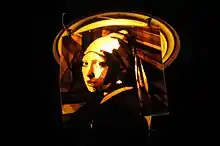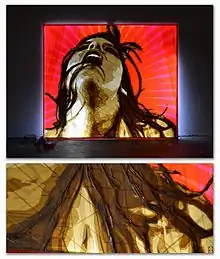Tape art
Tape art is an artwork created with adhesive tape such as duct tape or packing tape. It developed from urban art in the 1960s, as an alternative to the widely spread use of spray cans in the urban art scene. Tape can be used to produce a "stained glass" effect when applied to glass or plastic which is lit from behind. It can be attached to a wall to form the outline or an image, or can be shaped into three-dimensional sculptures.

Tape artists such as Max Zorn show their work at art fairs including Art Basel Miami.
Characteristics
Tape art can be installed quickly and almost silently, making it suitable for small or temporary urban art projects. No masking or covering is necessary. Tape is relatively easy to handle, and can be applied to various surfaces, such as stone, asphalt, wood, aluminum, sandwich panels or glass. Interior installations work just as well as exterior ones. Unlike spray paint art, tape art can be removed easily without leaving a permanent mark.
Materials for tape art vary depending on which tape is being used. Tape art can use duct tape, packing tape, masking tape or other products. Unlike traditional paintings and sculptures, tape art can be applied anywhere, including the doors, ceilings and floors of galleries. Duct tape can be used to construct three-dimensional sculptures.[1]
Gallery
 "Exit to..."- packing Tape art portrait of the first cosmonaut Yuri Gagarin by Berlin-based tape artist Slava Ostap. Brown packing tape on light-box. 2017.
"Exit to..."- packing Tape art portrait of the first cosmonaut Yuri Gagarin by Berlin-based tape artist Slava Ostap. Brown packing tape on light-box. 2017. Impala antelopes by Tape Over, created with duct tape and masking tape
Impala antelopes by Tape Over, created with duct tape and masking tape abstract wave by Tape Over Berlin
abstract wave by Tape Over Berlin Portable Tornado, a three-dimensional tape art installation by Slava Ostap, Berlin 2014
Portable Tornado, a three-dimensional tape art installation by Slava Ostap, Berlin 2014 Tape art by Pauline Fillioux
Tape art by Pauline Fillioux Packing tape art created by Slava Ostap
Packing tape art created by Slava Ostap shapes & lines - tape art mural by Tape Over at Upfest in Bristol/UK
shapes & lines - tape art mural by Tape Over at Upfest in Bristol/UK
Artists
- Slava Ostap
- Max Zorn (artist)
- Mark Khaisman
- Guillermo S. Quintana
- Achim Zeman
- Kerry Mott
References
External links
| Wikimedia Commons has media related to Tape art. |